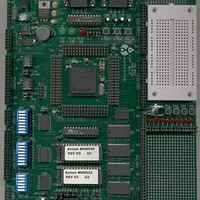MPC555CME Freescale Semiconductor, MPC555CME Datasheet - Page 495

MPC555CME
Manufacturer Part Number
MPC555CME
Description
KIT EVALUATION FOR MPC555
Manufacturer
Freescale Semiconductor
Type
Microcontrollerr
Datasheet
1.MPC555CME.pdf
(966 pages)
Specifications of MPC555CME
Contents
Module Board, Installation Guide, Power Supply, Cable, Software and more
Processor To Be Evaluated
MPC555
Data Bus Width
32 bit
Interface Type
RS-232
For Use With/related Products
MPC555
Lead Free Status / RoHS Status
Contains lead / RoHS non-compliant
- Current page: 495 of 966
- Download datasheet (13Mb)
14.7.5 Master Mode Operation
MPC555
USER’S MANUAL
possible combinations of clock phase and polarity can be specified by the CPHA and
CPOL bits in SPCR0.
Data is transferred with the most significant bit first. The number of bits transferred per
command defaults to eight, but can be set to any value from eight to sixteen bits by
writing a value into the BITS field in SPCR0 and setting BITSE in command RAM.
Typically, SPI bus outputs are not open drain unless multiple SPI masters are in the
system. If needed, the WOMQ bit in SPCR0 can be set to provide wired-OR, open
drain outputs. An external pull-up resistor should be used on each output line. WOMQ
affects all QSPI pins regardless of whether they are assigned to the QSPI or used as
general-purpose I/O.
Setting the MSTR bit in SPCR0 selects master mode operation. In master mode, the
QSPI can initiate serial transfers, but cannot respond to externally initiated transfers.
When the slave select input of a device configured for master mode is asserted, a
mode fault occurs.
Before QSPI operation begins, PQSPAR must be written to assign the necessary pins
to the QSPI. The pins necessary for master mode operation are MISO, MOSI, SCK,
and one or more of the chip-select pins. MISO is used for serial data input in master
mode, and MOSI is used for serial data output. Either or both may be necessary, de-
pending on the particular application. SCK is the serial clock output in master mode
and must be assigned to the QSPI for proper operation.
The PORTQS data register must next be written with values that make the QGPIO[6]/
SCK (bit 13 QDSCK of PORTQS) and QGPIO[3:0]/PCS[3:0] (bits 12:9 QDPCS[3:0] of
PORTQS) outputs inactive when the QSPI completes a series of transfers. Pins allo-
cated to the QSPI by PQSPAR are controlled by PORTQS when the QSPI is inactive.
PORTQS I/O pins driven to states opposite those of the inactive QSPI signals can gen-
erate glitches that momentarily enable or partially clock a slave device.
For example, if a slave device operates with an inactive SCK state of logic one (CPOL
= 1) and uses active low peripheral chip-select PCS[0], the QDSCK and QDPCS0 bits
in PORTQS must be set to 0b11. If QDSCK and QDPCS0 = 0b00, falling edges will
appear on QGPIO[6]/SCK and GPIO[0]/PCS[0] as the QSPI relinquishes control of
these pins and PORTQS drives them to logic zero from the inactive SCK and PCS[0]
states of logic one.
Before master mode operation is initiated, QSMCM register DDRQS is written last to
direct the data flow on the QSPI pins used. Configure the SCK, MOSI and appropriate
chip-select pins PCS[3:0] as outputs. The MISO pin must be configured as an input.
After pins are assigned and configured, write appropriate data to the command queue.
If data is to be transmitted, write the data to transmit RAM. Initialize the queue pointers
as appropriate.
/
MPC556
QUEUED SERIAL MULTI-CHANNEL MODULE
Rev. 15 October 2000
MOTOROLA
14-33
Related parts for MPC555CME
Image
Part Number
Description
Manufacturer
Datasheet
Request
R

Part Number:
Description:
MPC555 Interrupts
Manufacturer:
Freescale Semiconductor / Motorola
Datasheet:
Part Number:
Description:
Manufacturer:
Freescale Semiconductor, Inc
Datasheet:
Part Number:
Description:
Manufacturer:
Freescale Semiconductor, Inc
Datasheet:
Part Number:
Description:
Manufacturer:
Freescale Semiconductor, Inc
Datasheet:
Part Number:
Description:
Manufacturer:
Freescale Semiconductor, Inc
Datasheet:
Part Number:
Description:
Manufacturer:
Freescale Semiconductor, Inc
Datasheet:
Part Number:
Description:
Manufacturer:
Freescale Semiconductor, Inc
Datasheet:
Part Number:
Description:
Manufacturer:
Freescale Semiconductor, Inc
Datasheet:
Part Number:
Description:
Manufacturer:
Freescale Semiconductor, Inc
Datasheet:
Part Number:
Description:
Manufacturer:
Freescale Semiconductor, Inc
Datasheet:
Part Number:
Description:
Manufacturer:
Freescale Semiconductor, Inc
Datasheet:
Part Number:
Description:
Manufacturer:
Freescale Semiconductor, Inc
Datasheet:
Part Number:
Description:
Manufacturer:
Freescale Semiconductor, Inc
Datasheet:
Part Number:
Description:
Manufacturer:
Freescale Semiconductor, Inc
Datasheet:
Part Number:
Description:
Manufacturer:
Freescale Semiconductor, Inc
Datasheet:










